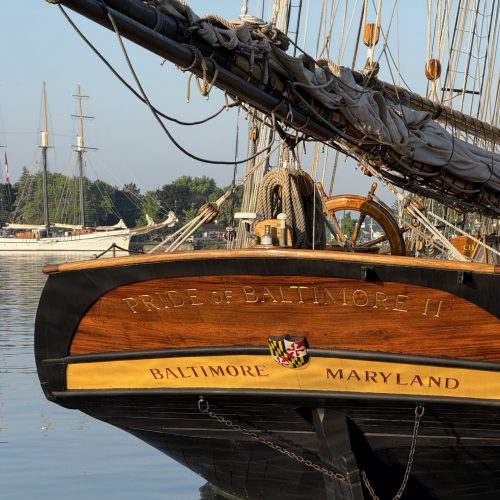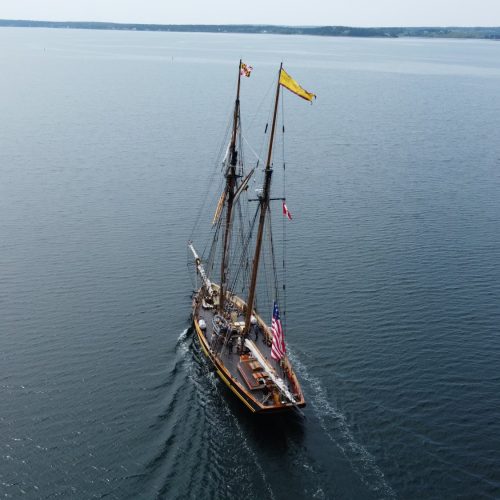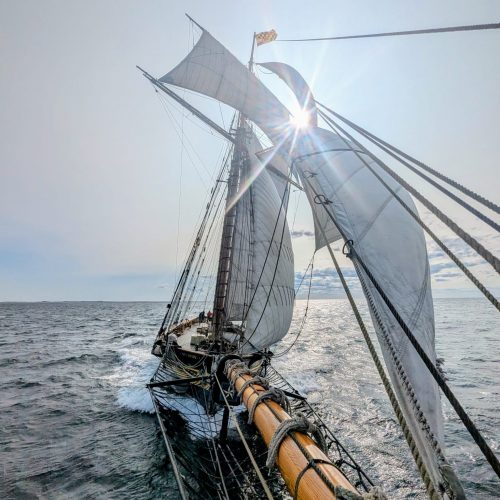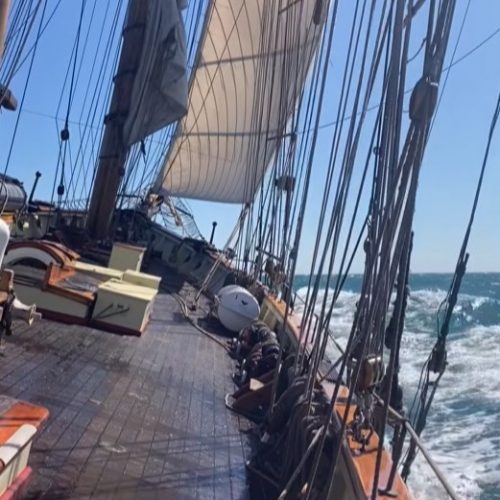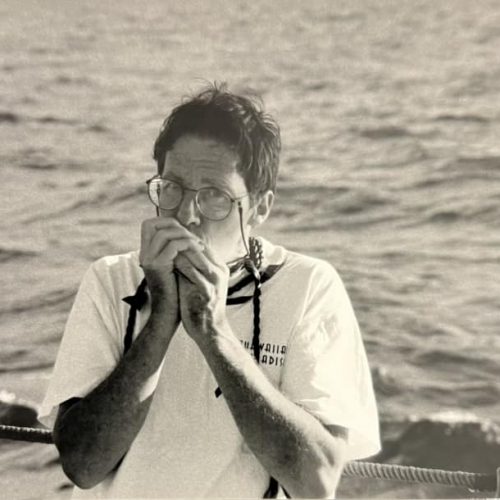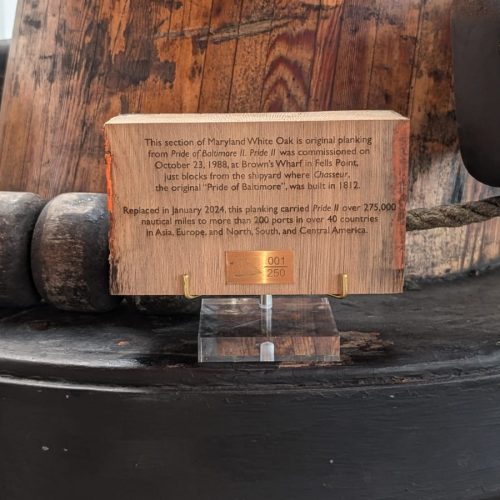LAKE HURON – IT’S GETTING COOLER AGAIN!
Pride II is hove-to in the northern part of Lake Huron, near the entrance to St. Mary’s River that flows from the “Soo Locks” located at Sault St. Marie, where Lake Superior begins its flow into Lake Huron. We finished the Lake Huron Tall Ships Challenge Race around 7:10 AM Wednesday morning. What began as a nail biting finish, trying to lead Brigg Niagra across the finish line—but she was overtaking at upwards of 2 knots faster than Pride II. It looked like she may overtake us before we crossed the finish a full hour protecting – we think, we hope – the time allowance Pride owed Niagra. With that happy ending after Niagra had been a significant threat the whole race, the following six hours was spent hove-to near the finish-line waiting to see if the quick Privateer Lynx would cross soon enough to rob Pride of first place through means of her handicap. First Mate Jill Hughes calculated it could be nearly three hours. Now, six hours since finishing, no other participating vessel has become visible. So, it seems likely Pride not only earned “line honors” for being the first in the fleet to cross the Lake Huron Tall Ships Race finish line, but has done it far enough ahead of the rest of the fleet to likely have also earned a first place finish based on handicap. We won’t know for sure until the award ceremonies some number of days ahead.
The welcome in Bay City was just as sincere and marked by vigorous hospitality and logistical support as it has proven to be for the previous four Bay City tall ships festivals occurring every three years. The liaison officers were most helpful to Pride’s new cook Tina, who came aboard last Thursday replacing our previous cook, Mark. Deckhand Sarah had been cook for a week after Captain Trost’s wife Kathleen had filled in for nearly three weeks. Between Sarah and the Bay City liaison officers, Tina had more assistance shopping for the next leg than ever has or is likely to happen with newly aboard cooks. In the meanwhile the crew and officers handled some 11,000 visitors over three days, as well all the usual extra things that occur around a tall ships festival – water replenishment, waste water pump out, electrical hook up, gangway set up and approval by safety oversight authorities, coordination with festival crowed-control volunteers, visits from refrigeration repair technicians, visits from portable propane storage tank re-certification technicians, coordinating and assisting with new food boarding and storage, welcoming and orienting new guest crew voyagers for the sail to Sault St. Marie, and the usual minor wear and tear maintenance Pride requires. All this plus each of the two crew watch groups were given a full day off – one group per day.
What started out as great summer weather in Bay City, by the end of the festival had turned into one of those typical summer heat waves. Temperatures into the low 90’s (considered high for Great Lake Region) with rising humidity. Official warnings and advisories were being announced frequently by all forms of public media. Advice to seek cool environments and drink lots of water and reduce physical activity. All great guidance and save for the drink lots of water advice not possible to abide aboard Pride. There are the ship needs at any time but also the voyage itinerary. So Pride departed Bay City bound for the next scheduled port with hopes there would be greater comfort away from the city out on the lake. Sadly, not much greater comfort was found. Sure, motoring along at 7 knots provided a deck breeze, but the water temperature was 75 degrees F. Anchoring on a calm wind night put an end to the mechanically provided breeze, but swim call sufficed as a substitute. At least for a few moments. Night time swelter had a few sleepers spread out on the hard wood deck (no shipboard bedding permitted on deck).
Smooth sea heaving-to is an interesting experience. Heaving-to was a common activity back before the age of power boating. It is a very effective way for a sail vessel to slow down, nearly stop, for any amount of time when wanting to wait for a while. (Wait for a pilot. Wait for daylight.) Two or more vessels may do it together so officers may visit directly aboard, but remember – no electricity, no radio, code flags or other signaling were inconvenient communications forms. Heaving-to required little of the crew. Turn the helm (rudder) hard to one side and adjust sail to prevent the ship from overpowering the rudder. Done with a sense for balance and the ship can lay oriented near head to wind, riding any moderate swell comfortably. The on watch crew can stand easy while keeping an eye to the weather and any other potential threat. The two off watch crews can be at rest in a vessel that is not moving around a lot under the influence of moderate wind and wave. Drift will occur when hove-to. So it is possible such will require re-arranging the heave-to in order to stay in an area or avoid drifting onto shore. Rough sea heaving-to is a totally different experience. Deciding to do so is often a matter of reducing motion for safety reasons or to provide rest to those on board. In today’s modern and busy maritime world being hove-to in rough conditions requires very diligent lookout for approaching shipping. There have been tragic collisions with big vessels not bothered by the rough conditions and not being aware a smaller vessel is in the area, hence unaware they might be steering right through a smaller hove-to stationary vessel.
STERLING HARBOR, ST. JOSEPH ISLAND, ONTARIO, CANADA OCCUPIED BY AMERICAN 1812 VESSELS
St. Joseph Island, Ontario, Canada has a small cove called Sterling Harbor on its southeast side. Sterling Harbor is a nearly undeveloped pristine cove. There are moderate sized private homes well spaced and much hidden by the local fauna. There are some private docks, but they are small being as they accommodate relatively small vessels (not more than 30 feet) and only a few of them. Mostly there are canoes and kayaks. As a result, this cove appears as natural as can be – at a quick glance.
In that cove are three American 1812 War-era sailing vessels at anchor. They are the only anchored vessels in the cove. If one squints their imagination, one can just about see it is 200 years ago, and the American Navy is at anchor. Maybe they are aware of coming weather – a cold front has been forecasted – and are waiting for it to pass before venturing forth again.
From a modern perspective the scene is pastoral. The vessels are handsome in epochal forms of their historical past. Nothing distracts from the view of them save the weather. It is intermittently overcast and lightly rainy with sunshine.
For those looking on from ashore there is nothing obvious indicating the types of activities taking place aboard. Aboard Pride there is detailed down below cleaning. All the nooks and crannies are being cleaned out and all exposed surfaces are being wiped clean. Niagra was indulging in a very untypical activity of the 1812 era… swim call. Lynx was quietly going about adjusting rig tension.
After several days of nonstop activity in back-to-back tall ship festival ports, with racing voyages in-between, this day of “rest and repair” is well received by Pride‘s crew. Our guest crew seem just as appreciative after some time in unrelieved heat with watch after watch sail handling of a racing voyage to the next tall ship festival port.
Tomorrow will come early as the ships get underway to form a parade past 1812 War era Old Fort Joe on the west side of the southern end of St. Joseph Island. Thence continue some 35 nautical miles up the St. Mary’s River to the Ontario Canada port of Sault St. Marie, set to arrive around 2:00 – 3:00 PM. Immediately upon arrival things get busy…very busy. Hopefully the cold front will have arrived and forced the heat away, at least for a short while.
Monday July 22, 2013
1300 Hours EDT
Position : 30 nautical miles east of Keweenaw Point
Currently we are enjoying 10.5 knots of sailing speed in high cirrus clouds and sun to the port side (south) with grey darkness to the starboard side (north) with the occasional rumble of thunder. Wind is from the south at a measured 25 knots. Pride is broad reaching with full sail. That means about 9,000 square feet of canvas shared between four lower sails, and four upper sails – they being the main-gaff-topsail, the square-fore-topsail, the jib-top-sail and the square-top-gallant-sail. The lower sails are the mainsail, the foresail, the forestaysail and the jib.
We started from “The Soo Locks” last night rather than waiting till this morning. A forecast of coming northwesterly winds for later today gave Pride and Lynx the incentive to use the favorable calm and southeasterly wind of last night and this morning to motor at cruising speed toward the Keweenaw Peninsula of Upper Michigan with hopes of being able to use this southerly wind to keep speed up and conserve fuel and possibly get into the western half of Lake Superior before the northwest winds arrived. Currently the strategy is going as anticipated. But we still have 6-10 hours to monitor for the actual arrival of the northwest winds and the possible rain and squalls that could be part of it. By midnight tonight we will know how well the strategy worked out. Did we avoid the stronger parts of the new wind? That was the key goal. Did we get far enough west to be able to use the northwest wind without having to tack away from the Keweenaw Peninsula northern shoreline? That is the secondary goal. Or did we have to take in most sail and motor some to the west to get to a point we can proceed under sail without having to thrash around a lot? Or will we wish we stopped to anchor on the south side of the Keweenaw Peninsula for the coming winds? Time will tell.
The local 1812 War history of Sault St. Marie, Ontario, Canada is a stark contrast to that of Baltimore, Maryland’s 1812 War history. Our hometown experienced a need to defend. The mixed race frontier citizens of the St. Mary’s River area with Sault St. Marie at the head waters executed a preemptive attack of The American Fort of what is today called Mackinaw Island (more properly spelled Mackinac following the Indian name for the island). This attack on the part of British military, local frontiersmen and “First Nation” natives preempted any initiative for attack by the Americans. This preemptive action protected the “Canadian” residents of the St. Mary’s River area from American aggression for the duration of the war.
This story was told at a theater performance right after desert of the formal welcome diner for the visiting 1812 War Era Tall Ship Captains and First Officers. The room of over 100 attendees was filled with rein-actor uniforms. The theater show was a series of dialogues representing actual characters of the period. A lot of emotion was depicted of the stress having to consider such a preemptive action against what was otherwise a friendly neighbor nation that was expressly attacking to the north for reasons of obtaining a bargaining chip with England. The attack on Mackinaw Island is reported to be the first actual combat of the War of 1812.
Our Sault St. Marie hosts were gracious and attentive to the realities of visiting sailing vessels allowing their decks to be visited by local citizens. The citizens were most respectful of their opportunity to visit aboard, some 7,000 of them over the course of Saturday and Sunday.
Departure required Customs clearance from Canada and because the USA is only a half a mile across the river, we made American Customs clearance immediately after in Sault St. Marie, Michigan. We departed the Canadian shore at 6:45 PM and arrived on the American shore at 7 PM. We departed again at 8:20 PM and navigated the 21 vertical feet of the Soo Locks by 9:30 PM. With our fresh southerly wind at this moment, we could reach the eastern most tip of the Keweenaw Peninsula around 4 PM. The further west we can sail before wind change the better off I think we will be at the actual time of wind change to the northwest.
Jan C. Miles & the very happily sailing crew of Pride of Baltimore II

